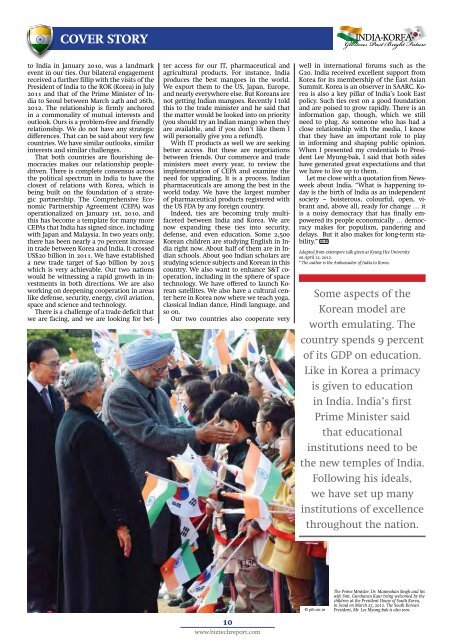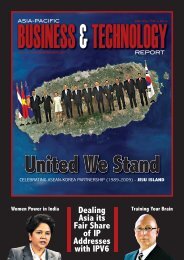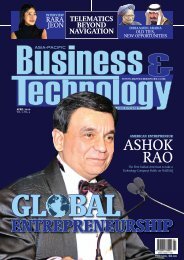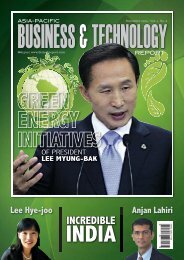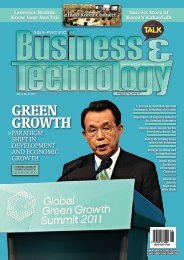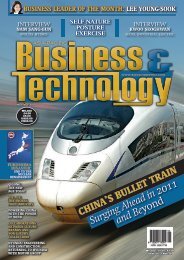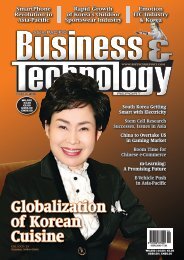INDIA-KOREA - Asia-Pacific Business and Technology Report
INDIA-KOREA - Asia-Pacific Business and Technology Report
INDIA-KOREA - Asia-Pacific Business and Technology Report
You also want an ePaper? Increase the reach of your titles
YUMPU automatically turns print PDFs into web optimized ePapers that Google loves.
cover story<br />
<strong>INDIA</strong>-<strong>KOREA</strong><br />
Glorious Past Bright Future<br />
to India in January 2010, was a l<strong>and</strong>mark<br />
event in our ties. Our bilateral engagement<br />
received a further fillip with the visits of the<br />
President of India to the ROK (Korea) in July<br />
2011 <strong>and</strong> that of the Prime Minister of India<br />
to Seoul between March 24th <strong>and</strong> 26th,<br />
2012. The relationship is firmly anchored<br />
in a commonality of mutual interests <strong>and</strong><br />
outlook. Ours is a problem-free <strong>and</strong> friendly<br />
relationship. We do not have any strategic<br />
differences. That can be said about very few<br />
countries. We have similar outlooks, similar<br />
interests <strong>and</strong> similar challenges.<br />
That both countries are flourishing democracies<br />
makes our relationship peopledriven.<br />
There is complete consensus across<br />
the political spectrum in India to have the<br />
closest of relations with Korea, which is<br />
being built on the foundation of a strategic<br />
partnership. The Comprehensive Economic<br />
Partnership Agreement (CEPA) was<br />
operationalized on January 1st, 2010, <strong>and</strong><br />
this has become a template for many more<br />
CEPAs that India has signed since, including<br />
with Japan <strong>and</strong> Malaysia. In two years only,<br />
there has been nearly a 70 percent increase<br />
in trade between Korea <strong>and</strong> India. It crossed<br />
US$20 billion in 2011. We have established<br />
a new trade target of $40 billion by 2015<br />
which is very achievable. Our two nations<br />
would be witnessing a rapid growth in investments<br />
in both directions. We are also<br />
working on deepening cooperation in areas<br />
like defense, security, energy, civil aviation,<br />
space <strong>and</strong> science <strong>and</strong> technology.<br />
There is a challenge of a trade deficit that<br />
we are facing, <strong>and</strong> we are looking for better<br />
access for our IT, pharmaceutical <strong>and</strong><br />
agricultural products. For instance, India<br />
produces the best mangoes in the world.<br />
We export them to the US, Japan, Europe,<br />
<strong>and</strong> nearly everywhere else. But Koreans are<br />
not getting Indian mangoes. Recently I told<br />
this to the trade minister <strong>and</strong> he said that<br />
the matter would be looked into on priority<br />
(you should try an Indian mango when they<br />
are available, <strong>and</strong> if you don’t like them I<br />
will personally give you a refund!).<br />
With IT products as well we are seeking<br />
better access. But these are negotiations<br />
between friends. Our commerce <strong>and</strong> trade<br />
ministers meet every year, to review the<br />
implementation of CEPA <strong>and</strong> examine the<br />
need for upgrading. It is a process. Indian<br />
pharmaceuticals are among the best in the<br />
world today. We have the largest number<br />
of pharmaceutical products registered with<br />
the US FDA by any foreign country.<br />
Indeed, ties are becoming truly multifaceted<br />
between India <strong>and</strong> Korea. We are<br />
now exp<strong>and</strong>ing these ties into security,<br />
defense, <strong>and</strong> even education. Some 2,500<br />
Korean children are studying English in India<br />
right now. About half of them are in Indian<br />
schools. About 900 Indian scholars are<br />
studying science subjects <strong>and</strong> Korean in this<br />
country. We also want to enhance S&T cooperation,<br />
including in the sphere of space<br />
technology. We have offered to launch Korean<br />
satellites. We also have a cultural center<br />
here in Korea now where we teach yoga,<br />
classical Indian dance, Hindi language, <strong>and</strong><br />
so on.<br />
Our two countries also cooperate very<br />
well in international forums such as the<br />
G20. India received excellent support from<br />
Korea for its membership of the East <strong>Asia</strong>n<br />
Summit. Korea is an observer in SAARC. Korea<br />
is also a key pillar of India’s Look East<br />
policy. Such ties rest on a good foundation<br />
<strong>and</strong> are poised to grow rapidly. There is an<br />
information gap, though, which we still<br />
need to plug. As someone who has had a<br />
close relationship with the media, I know<br />
that they have an important role to play<br />
in informing <strong>and</strong> shaping public opinion.<br />
When I presented my credentials to President<br />
Lee Myung-bak, I said that both sides<br />
have generated great expectations <strong>and</strong> that<br />
we have to live up to them.<br />
Let me close with a quotation from Newsweek<br />
about India. “What is happening today<br />
is the birth of India as an independent<br />
society – boisterous, colourful, open, vibrant<br />
<strong>and</strong>, above all, ready for change … it<br />
is a noisy democracy that has finally empowered<br />
its people economically … democracy<br />
makes for populism, p<strong>and</strong>ering <strong>and</strong><br />
delays. But it also makes for long-term stability.”<br />
A-P<br />
Adapted from extempore talk given at Kyung Hee University<br />
on April 12, 2012.<br />
* The author is the Ambassador of India to Korea.<br />
Some aspects of the<br />
Korean model are<br />
worth emulating. The<br />
country spends 9 percent<br />
of its GDP on education.<br />
Like in Korea a primacy<br />
is given to education<br />
in India. India’s first<br />
Prime Minister said<br />
that educational<br />
institutions need to be<br />
the new temples of India.<br />
Following his ideals,<br />
we have set up many<br />
institutions of excellence<br />
throughout the nation.<br />
© pib.nic.in<br />
The Prime Minister, Dr. Manmohan Singh <strong>and</strong> his<br />
wife Smt. Gursharan Kaur being welcomed by the<br />
children at the President House of South Korea,<br />
in Seoul on March 25, 2012. The South Korean<br />
President, Mr. Lee Myung-bak is also seen.<br />
10<br />
www.biztechreport.com


